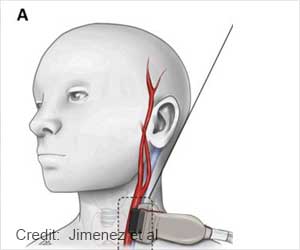University of Iowa researchers have shown that a protein channel helps nerve sensors in blood vessels keep blood pressure in check.
University of Iowa researchers have shown that a protein channel helps nerve sensors in blood vessels keep blood pressure in check. Without the protein channel, known as ASIC2, the sensors are unable to send the brain the signals it needs to properly control blood pressure.
The finding, which was based in animal models, is important because it could be used to create new treatments to prevent high blood pressure (hypertension). The study results appear in the Dec. 24 print issue of the journal Neuron."Sensors in your body's blood vessels sense when your blood pressure goes up, for instance, when you get mad at someone," said the study's principal investigator Frank Abboud, M.D., professor of internal medicine and molecular physiology and biophysics at the University of Iowa Carver College of Medicine and director of the Cardiovascular Research Center at the University of Iowa. "These built-in sensors perceive the change and trigger a nearly instantaneous adjustment by sending signals to the brain, which in turn tells the blood vessels how to adjust.
"By knowing more about what makes these sensors - known as baroreceptors - malfunction, we may be able to find ways to make them work properly and prevent high blood pressure," added Abboud, who also holds the Edith King Pearson Chair in Cardiovascular Research and is emeritus head of the University of Iowa Department of Internal Medicine.
In the current study, the team showed that the ASIC2 channel was present in the nerve cells of mice blood vessels and that when the channel was defective, the nerve activity was also defective. They also created a mouse model that did not have the gene that codes for the protein channel and thus had no ASIC2 channels. These mice without ASIC2 channels had high blood pressure. The channels play a key role in the electrical activity that is needed to control blood pressure.
"The ASIC2 channel allows a current to be generated at the nerve endings in blood vessels," he said. "However, when there is no ASIC2, those nerve endings become defective and cannot produce electrical current, and the nervous system loses the ability to get the blood vessels to dilate when necessary. As a result, the vessels remain constricted and the blood pressure stays high even when it should not."
The finding builds on previous research by Abboud, University of Iowa colleagues and other investigators, thanks in part to attention paid years earlier to an organism that may seem to have little in common with humans, a worm. Abboud said that previous studies done in the 1990s in the worm C. elegans showed that certain mechanosensors were needed for the worm to perceive touch. When a particular gene was absent, the worm lost the function of those mechanosensors.
Advertisement
"The blood vessel sensors in the neck keep blood pressure from getting too high or too low. Based on what we saw at that time, we studied rat models and found genes coding for sensors. With this current study, we were able to expand our investigation and identify the function of the protein channel expressed by the gene," he added.
Advertisement
Addressing how many years of research had come to fruition, Abboud said, "The interdisciplinary knowledge and collaboration, clinical observation and making a leap from what we saw in a worm to what we could see in animals, this all came together to advance our understanding of how these sensors control blood pressure."
Source-Eurekalert
SRM














